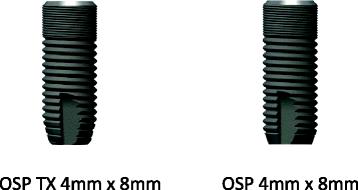Dental implants, Implant stability, OsseoSpeed™, OsseoSpeed TX™, Resonance frequency analysis, Osstell™, Implant survival
Fig. 1. Implant design. The OSPTX and OSP implants are manufactured from high-grade commercially pure titanium with surface roughness produced via a fluoride treatment process. The OSP implant is a screw-shaped self-tapping implant. The diameter used in this study was 4.0 mm. The implant length used in this study was 8 mm. The OSPTX implant has the same features as the OSP except the apex of the implant is tapered : Comparative evaluation of the stability of two different dental implant
author: David E Simmons, Pooja Maney, Austin G Teitelbaum, Susan Billiot, Lomesh J Popat, A Archontia Palaiologou | publisher: drg. Andreas Tjandra, Sp. Perio, FISID

Fig. 1. Implant design. The OSPTX and OSP implants are manufactured from high-grade commercially pure titanium with surface roughness produced via a fluoride treatment process. The OSP implant is a screw-shaped self-tapping implant. The diameter used in this study was 4.0 mm. The implant length used in this study was 8 mm. The OSPTX implant has the same features as the OSP except the apex of the implant is tapered
Serial posts:
- Abstract : Comparative evaluation of the stability of two different dental implant designs and surgical protocols—a pilot study [2]
- Background : Comparative evaluation of the stability of two different dental implant designs and surgical protocols—a pilot study [1]
- Background : Comparative evaluation of the stability of two different dental implant designs and surgical protocols—a pilot study [2]
- Methods : Comparative evaluation of the stability of two different dental implant designs and surgical protocols—a pilot study [1]
- Methods : Comparative evaluation of the stability of two different dental implant designs and surgical protocols—a pilot study [2]
- Results : Comparative evaluation of the stability of two different dental implant designs and surgical protocols—a pilot study
- Discussion : Comparative evaluation of the stability of two different dental implant designs and surgical protocols—a pilot study [1]
- Discussion : Comparative evaluation of the stability of two different dental implant designs and surgical protocols—a pilot study [2]
- Conclusions : Comparative evaluation of the stability of two different dental implant designs and surgical protocols—a pilot study
- Notes : Comparative evaluation of the stability of two different dental implant designs and surgical protocols—a pilot study
- References : Comparative evaluation of the stability of two different dental implant designs and surgical protocols—a pilot study [1]
- References : Comparative evaluation of the stability of two different dental implant designs and surgical protocols—a pilot study [2]
- References : Comparative evaluation of the stability of two different dental implant designs and surgical protocols—a pilot study [3]
- Author information : Comparative evaluation of the stability of two different dental implant designs and surgical protocols—a pilot study
- Rights and permissions : Comparative evaluation of the stability of two different dental implant designs and surgical protocols—a pilot study
- About this article : Comparative evaluation of the stability of two different dental implant designs and surgical protocols—a pilot study
- Table 1 Patient selection criteria : Comparative evaluation of the stability of two different dental implant designs and surgical protocols—a pilot study
- Table 2 Outcome success criteria : Comparative evaluation of the stability of two different dental implant designs and surgical protocols—a pilot study
- Fig. 1. Implant design. The OSPTX and OSP implants are manufactured from high-grade commercially pure titanium with surface roughness produced via a fluoride treatment process. The OSP implant is a screw-shaped self-tapping implant. The diameter used in this study was 4.0 mm. The implant length used in this study was 8 mm. The OSPTX implant has the same features as the OSP except the apex of the implant is tapered : Comparative evaluation of the stability of two different dental implant
- Fig. 2. ISQ values at placement, 6 weeks, 6 months, and 1 year. Mean and standard deviation of ISQ values taken at placement, 6 weeks, 6 months, and 1 year is presented. No statistical significant difference was determined between ISQ values at all time points. (p < 0.05) : Comparative evaluation of the stability of two different dental implant
- Fig. 3. Mean bone loss at 6 months and 1 year. Mean bone loss distribution charts at 6 months and 1 year present no statistically significant difference. p value at 6 months was 0.2981 and at 1 year 0.6613 : Comparative evaluation of the stability of two different dental implant